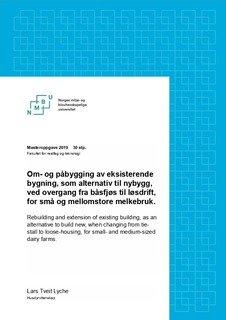| dc.contributor.advisor | Ebert, Martin | |
| dc.contributor.advisor | Wiik, Tore | |
| dc.contributor.author | Lyche, Lars Tveit | |
| dc.coverage.spatial | Norway | nb_NO |
| dc.date.accessioned | 2019-10-02T08:54:42Z | |
| dc.date.available | 2019-10-02T08:54:42Z | |
| dc.date.issued | 2019 | |
| dc.identifier.uri | http://hdl.handle.net/11250/2619812 | |
| dc.description.abstract | I Norge har stortinget bestemt at alle kyr skal stalles opp i løsdrift senest fra 1. jan. 2034. Enda er faktisk så mye som 2/3 av landets melkeproduksjonsfjøs båsfjøs. Overgangen til løsdrift krever store innvesteringer i bygninger, som kan være en utfordring å bære på mange små og mellomstore bruk, der det ikke finnes jordgrunnlag for å øke produksjonen. Målet med denne oppgaven er derfor å undersøke om det for disse kan være aktuelt med om- og påbygging av eksisterende båsfjøs, og med det gjøre det mulig å innfri løsdriftskravet.
I tillegg til å finne informasjon om vanlige utforminger og byggemåter for båsfjøs, ble et båsfjøs fra 1980 valgt ut som modellbygg for oppgaven. Dette bygget ble analysert og to nye løsdrifter, én for melkekyr og én for ungdyr, ble planlagt i henhold til de norske anbefalingene til hus for storfe. Begge løsningene baserer seg på liggebåser og spaltegulv på gjødselarealet.
Basert på erfaringene gjort i forbindelse med dette arbeidet kan det slås fast at om- og påbygging av eksisterende fjøs kan være et godt alternativ til nybygg for små og mellomstore melkebruk og at oppdeling av melkekyr og ungdyr i hver sine avdelinger/bygninger kan være fornuftig. | nb_NO |
| dc.description.abstract | In Norway, the Government has decided that all cows should be stalled in loose-house systems by January 1st. 2034. Even today, as much as 2/3 of the country's milk is produces in tie-stall barns. The transition to loose-house systems requires large investments in buildings, which can be a challenge to bear on many small and medium-sized dairy farms, where there is no land for increasing production. The aim of this task is therefore to investigate whether it can be relevant for these farms to use rebuilding and extension of the existing barn, and with this make it possible to meet the requirement of loose-house system.
In addition to finding information on common designs and construction methods for tie-stall barns, a representative barn from 1980 was selected as a model-building for the task. This building was analysed, and two new loose-house solutions were made, one for dairy cows and one for juveniles. They were planned according to the Norwegian recommendations for cattle houses. Both solutions are based on cubicles and slatted floors on the fertilizer area.
Based on the experience gained in connection with this work, it can be stated that the rebuilding and extension of existing barns can be a good alternative to new buildings for small and medium-sized dairy farms, and that it can be reasonable to divide the dairy cows and juveniles into their respective departments / buildings. | nb_NO |
| dc.language.iso | nob | nb_NO |
| dc.publisher | Norwegian University of Life Sciences, Ås | nb_NO |
| dc.rights | Attribution-NonCommercial-NoDerivatives 4.0 Internasjonal | * |
| dc.rights.uri | http://creativecommons.org/licenses/by-nc-nd/4.0/deed.no | * |
| dc.title | Om- og påbygging av eksisterende bygning, som alternativ til nybygg, ved overgang fra båsfjøs til løsdrift, for små og mellomstore melkebruk | nb_NO |
| dc.title.alternative | Rebuilding and extension of existing building, as an alternative to build new, when changing from tiestall to loose-housing, for small- and medium-sized dairy farms | nb_NO |
| dc.type | Master thesis | nb_NO |
| dc.subject.nsi | VDP::Landbruks- og Fiskerifag: 900 | nb_NO |
| dc.source.pagenumber | 100 | nb_NO |
| dc.description.localcode | M-BA | nb_NO |

